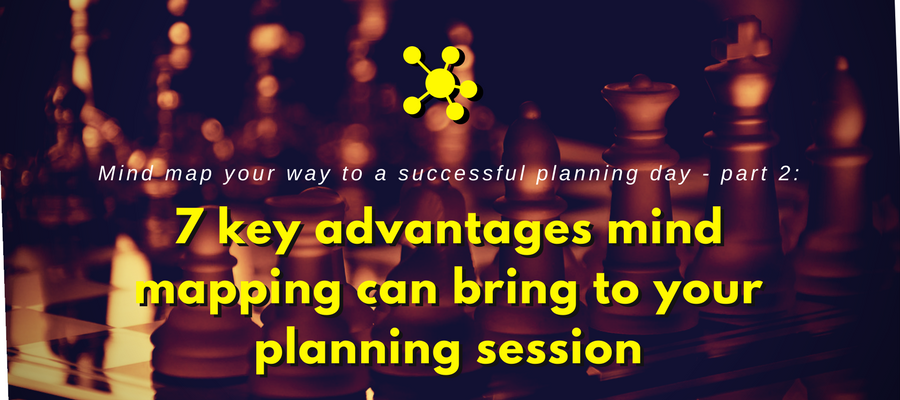7 key advantages mind mapping can bring to your planning session
(This is part 2 of a 5-part series on how to conduct a successful planning day using mind mapping software, by Alex Gooding)
Mind mapping software can bring numerous advantages to the strategic planning process. In this article, the second in our series on how to run planning workshops, we’ll investigate seven specific advantages it offers compared to traditional methods like whiteboarding.
1. Speed
In my experience, it is easier to stay on schedule during planning sessions that are run with mind mapping than those using a traditional whiteboard. A lot naturally depends on the skills of the facilitator, but mind mapping offers several practical advantages.
First, the facilitator can move much faster through the planning day without having to stop regularly to clear the screen to write up the next topic. Second, the facilitator can add participant responses to the map quickly and accurately. Finally, a mind map can be expanded on-screen as ideas are added. Contrast this with using a whiteboard, where the session has to stop every time the board is full so that it can be recorded in one or more photos and then erased so the planning process can continue.
2. Transparency
With a mind map, people can see easily if their ideas are being recorded accurately by the facilitator or scribe and how their ideas relate to previous comments shared by their peers. The facilitator can also print or even email summary snapshots of the evolving map to participants in real time as the planning day progresses. This process can help everyone understand how the discussions have developed during the planning session. After the session is over, participants can compare the snapshots to the final write-up to see how their responses have been incorporated into the outcomes.
3. Engagement
The transparency of the mind mapping process also supports greater engagement by the participants. Everything is much clearer on a mind map compared to a whiteboard – not only the comments themselves, but also the connections between those comments and the key map topics. As a result participants can see the plan evolve thorough their input and share additional thoughts that also get added into the evolving plan.
4. Focus
Using a mind map, the facilitator can highlight specific topics for discussion, making the rest of the map “disappear” temporarily. This makes it much easier to keep everyone on track. Conversely, the facilitator can show a whole branch with multiple topics, helping team members to see how they are related. This is also a useful tool for showing topics lacking responses, which may indicate they may need more consideration and input from the group.
These features also make it easier to respond if the discussion starts to go off-topic. Anyone who has ever facilitated a planning day will understand this problem – a brilliant idea (or a not-so-helpful suggestion) is blurted out by a participant. But it has nothing to do with the topic currently being discussed; suddenly the workshop has veered off onto a tangent.
With a mind map, it is much easier to “park” those comments by recording them on screen, but then “hide” them from immediate view, so they won’t distract the group. These ideas don’t disappear – they can be discussed later, but the parking process helps the facilitator to maintain the subtle pressure to stay on-topic.
5. Flexibility
One of the core advantages of a mind map over a whiteboard is the ease with which ideas can be grouped and moved around the screen in real time during the planning session. Not only individual topics and comments can be handled this way – entire branches with multiple topics can also be easily moved, restructured or added to the map.
At its most basic level, this makes it easier for the facilitator to respond if a participant suggests that their comments have been put in the wrong place. More importantly, it allows a skilled facilitator to shape the planning session by grouping related ideas as participants share them. They can be attached to relevant existing topics, or the facilitator can create new topics to accommodate them.
Individual responses can that deal with a new issue or idea also be highlighted and used as the “parent” topic for further comments. Relationship lines can also be drawn between comments that may be attached to different topics but which share something important in common. This flexibility also makes it easy for the facilitator to create lists of topics or responses and ask the group to prioritize or rank them.
6. Efficiency
Some of the features I’ve already mentioned also contribute to another advantage of a mind map compared to a whiteboard – efficiency. For example, there is no need for the facilitator to spend a lot of time transcribing a scrawl of handwritten notes at the end of the session – the material is already there, typed up and ready for a final edit. This means that the outcomes can be produced much faster, even immediately after the planning session has ended.
7. Adaptability
There is a final killer advantage of using mind maps over whiteboards to run your next planning day – adaptability.
Whiteboards are essentially static. Even if it has wheels, I bet your organization’s whiteboard spends most of its time in your meeting room; anything anyone does with it there is usually transcribed, then transferred and converted into useful outcomes somewhere else. While there are some programs which assist in this process, the paradigm essentially remains the same.
A mind map is the complete opposite. The screen or monitor that’s used for a mind-mapped planning workshop is just a vehicle for display. Everything that’s done during the session stays within the mind map and consequently with the facilitator, at least initially. What happens next is up to the facilitator and the organization, but there is a range of other options for sharing it. As mentioned earlier, the outcomes can be distributed to attendees at the end of the planning session. Most mind mapping programs also make it easy to export the outcomes directly into Word documents for further editing. In addition, many of them can export map contents to spreadsheets, project management programs and team collaboration tools like Sharepoint.
In addition to serving as a thinking and planning tool, another capability of mind mapping software points to its supreme adaptability. In many cases, the mind map can be converted into an ongoing planning and management tool for your team. Specific features vary from program to program, but most of the more mature mind mapping tools enable you to enter task-related data for each of the actions identified in a planning session, such as start and end dates, resources, priorities and progress to date.
Some even allow you to display task information as a Gantt chart or as timeline which can be updated to display the team’s implementation progress. We are not necessarily talking here about the level of sophistication of, say, Microsoft Project, but most of the major mind mapping programs have more than enough features to be great project management tools for smaller teams and organizations.
Next: How to prepare to make your first mind mapping planning day a success.
Alex Gooding is an Australian consultant specialising in governance, strategic planning and organisation management who lives and works in the Blue Mountains, 90 kilometres (60 miles) west of Sydney. Alex also provides practical advice on mind mapping techniques and benefits, particularly for small organisations, through his Sociamind blog.
To learn more about the benefits of mind mapping software for strategic planning, check out my new e-course.
Other articles in this series
Part 1: Strategic planning – Stuck in the whiteboard time warp



Leave a Reply